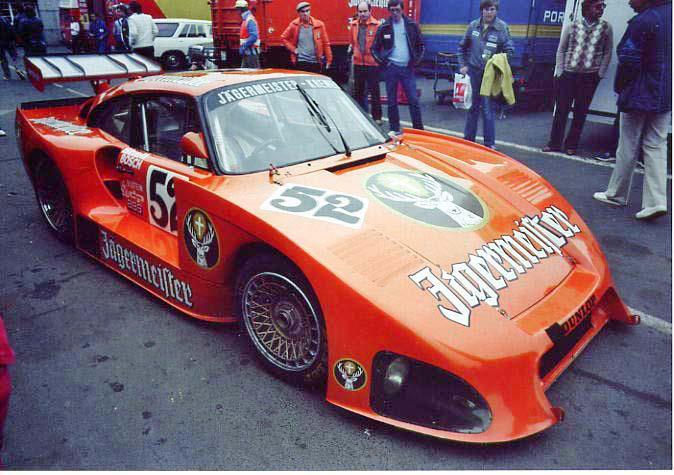I've always loved this Porsche...stunning to look at, but I'd say the body is more like the 935 in the top right hand corner of the picture below than the Moby Dick 935, which is the one in the bottom right corner. (You can see why that one was called Moby Dick). Both are 1978 models.
Yes, the K3's bodywork was never quite as extreme as the full 'Moby Dick' (Langheck) style the factory developed for the '78 Le Mans effort. The Kremer Brothers never went for the 935-78 style, the K3's bodywork being developed from the factory 935-77 style instead. It was Reinhold Joest who built the two factory-sanctioned replicas at the end of 1980 which were raced by Gianpiero Moretti's Momo Corse and John Fitzpatrick Racing (in whose car Rolf Stommelen was tragically killed in a 1983 IMSA race when the rear wing failed).
There were a few other unofficial replicas built in the USA by private teams for for the IMSA championship, such as the Andial 935 (originally built for Howard Meister, but later run with some success by Preston Henn):

FABCAR also built a 935 'special' for John Paul Jones and his son (John Paul Jr) insipred by 'Moby Dick', known as the 935JLP-4. This was even more radical than the factory cars and retained virtually none of the original 935 bodywork or chassis (IMSA regs were far more relaxed about modifications than the FIA Group 5 regs that the European cars were built to, and only the roof and windscreen needed to be retained). JLP-4 was built for the 1981 season and featured a full monocoque chassis (unlike the 'Moby Dick' tubular spaceframe) and ground effect aerodynamics:



Bob Akin commissioned GAACO to build him the 'ultimate' 935 for the 1982 IMSA season. Again, this used a full monocoque chassis and ground effect aerodynamics, and radical bodywork that was even more unrecognisable as a 935 than JLP-4 (the front bodywork from a Lola T600 GTP car was grafted on for better aerodynamics):



The car was said to be incredibly fast in a straight line, but the handling in corners was diabolical - so much so that after it retired from the 1982 Le Mans, Akin was quoted as saying 'Good, I wasn't looking forward to driving it for 24 hours!'.
However, it was the Kremer K3 that proved to be the most successful of all the 935 variants (the K3 being the only 935 variant to win Le Mans outright in 1979):

The K3 was developed for the Kremer's own team in the 1979 season. It featured a number of improvements over the factory 935s such as lighter kevlar bodywork, a false rear roof skin and window that sat on top of the original to improve airflow onto the rear wing and, most important of all, replaced the factory water-to-air intercoolers with air-to-air units, which drastically improved the engine's ability to run at higher boost levels for longer without overheating. As well as Le Mans, it won 11 of the 12 DRM (German Sportscar Championship) races in 1979.
This success generated demand from prospective customers, so in 1980 Kremer started building K3s for sale. A total of 13 new cars were built from spare race-spec shells from Porsche, and 3 935K2s were converted to K3 spec (2 were Kremer's own 1978 cars and 1 was from a Japanese customer). Kits were also sold for other race teams to do their own conversions, and lots of K3 clones appeared on the circuits in the following seasons, such as John Paul Jones' 935JLP-3, which was a GAACO-built evolution of the K3 which was used to win the 1982 IMSA championship:

The 935 (particularly the derivatives of the K3) remained competitive in top-level racing up to the 1984 season.
Like Joest, Porsche did allow the Kremer Brothers access to the plans for the 935-78 'Moby Dick' car, but unlike Joest they did not build a direct replica. Instead, they took the spaceframe chassis design and designed their own bodywork to provide much more downforce (the low-downforce 'Langheck' factory body design was a compromise that was only intended for the long straights at Le Mans) and redesigned suspension. This new car became the Kremer K4. Only 2 K4s were built. The first was run by Kremer themselves for the 1981 season:

Although they won the Porsche Cup that season, the suspension modifications they had made did not work as well as hoped and resulted in handling issues. The car was then sold to John Fitzpatrick Racing for the 1982 IMSA season (as the sister car to their Joest 'Moby Dick' replica). Fitzpatrick made some major modifications to the suspension and bodywork, most importantly moving the intakes for the intercoolers to prevent overheating:

The second car was built for Interscope Racing also for use in IMSA, but ended up never being raced as it suffered from the same overheating problems in testing and the team continued to run thier K3s while developing their Lola T600 GTP cars instead:













































